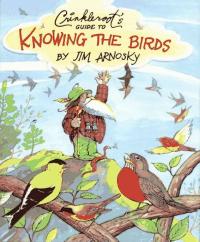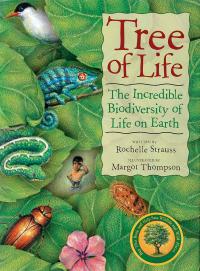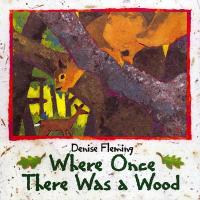
The true and truly amazing tale of how Yoshi, a rescued loggerhead turtle, found his way back to his home territory many years after being rehabilitated and housed in an aquarium. Illustrations evoke the water world in which Yoshi was found, lived, and traveled. A final word and a photograph of Yoshi conclude this handsome and engaging look at a phenomenon of nature.
Yoshi Sea Turtle Genius

Enjoy the feel of what swimming in a pool, a lake, and the ocean through beautifully rendered watercolors and lyrical text. Endpapers show a girl starting at one end of a swimming pool until she reaches the other side show on the final endpapers. In between, share the water with a range of swimmers of many ages, sizes, and hues.
When You Can Swim

What would your world look like if you were as small as a bean? Find out from the perspective of Jumper, a small spider that is both prey and hunter. Lush, realistic watercolor illustrations accompanied by engaging and informative text. Fascinating back matter and additional resources conclude this handsome volume.
Jumper: A Day in the Life of a Backyard Jumping Spider

A variety of big-eyed animals peek out from their abode and declare where they live. From nest to tree dwellers, from burrows to farms, each animal announces their home — concluding with young children cozily ensconced in their beds. This jaunty book is sure to engage and (sort of) inform about animal homes.
I Live in a Tree Trunk

Spanish and English are both used to tell the story of a girl and her family making apple treats, following their tree from flower to fruit. Told in a familiar cadence, the poem embeds Spanish words seamlessly to accompany jaunty illustrations. A glossary of Spanish words used and an easy recipe for applesauce are included.
Apple Pie Picnic

A bright frog face with big googly eyes invites young readers in to witness its transformation from egg to tadpole to full grown frog. Die-cuts are used throughout to enhance the simple drama of the frog’s growth.
Frog

Spare, poetic text and breathtaking pictures invite readers on a journey that gently illuminates the causes of climate change as well as how our individual and collective actions can make the world better. Clear endnotes vetted by a climate expert answer a myriad of questions in simple language.
To Change a Planet

Crinkleroot shares the excitement and rewards of birdwatching, in a beginner’s guide that offers tips on identifying more than fifty birds and includes facts about bird anatomy, behavior, life cycles, and more.
Crinkleroot’s Guide to Knowing the Birds

Since 2031, Aviary Wonders Inc. has offered bird lovers a unique opportunity: Assemble your own bird from stunningly beautiful and carefully hand-crafted parts. The birds can even be taught to fly and to sing! This slyly satirical crafter’s delight is offered as the perfect antidote to extinction of birds in the wild. Illustrated with oil paintings and filled with laugh-aloud asides as well as sobering facts about extinct species, this mock catalog is a clever send-up of contemporary sales spin and a thought-provoking look into an all-too-possible future.
Aviary Wonders Inc. Spring Catalog and Instruction Manual

A look at the fascinating natural world of plants. Real-life photographs of flowers, fruits, seeds, leaves, and more offer a unique “eyewitness” view of the natural history of plant anatomy and growth. See the biggest flower in the world, where a seed develops, what the inside of a plant stem looks like, how a flower attracts insects, what a plant’s reproductive organs look like, how a dandelion spreads its seeds, and much more.
DK Eyewitness Books: Plant

Why do beekeepers use smoke machines when collecting honey? Can a bee really sting only once? Why do bees “dance”? Get an introduction to the life cycle, social organization, and history of one of the world’s most useful insects. Learn how bees make honey, what a beekeeper does, and products that contain beeswax — everything from lipstick to waxes for buffing surfboards.
The Life and Times of the Honeybee

A youngNative American boy carves a little canoe with a figure inside and names him Paddle-to-the-Sea. Paddle’s journey, in text and pictures, through the Great Lakes to the Atlantic Ocean provides an excellent geographic and historical picture of the region.
Paddle-to-the-Sea

Beginning and ending with discussions of the water cycle, Hiscock explains that the three rivers gather water from throughout the middle of the U.S. and form the world’s third largest tidal basin. The book focuses on the 1993 floods in the Midwest, showing how unusual weather patterns affected rainfall, what happened when the rivers overflowed their banks, and how people prepared for the flooding and handled it after it came.
The Big Rivers: The Missouri, the Mississippi, and the Ohio

When Ms. Frizzle drives the Magic School Bus full speed ahead into the ocean, the class takes a submarine expedition that’s anything but ordinary. With a well-meaning lifeguard in tow, the class takes a deep breath and learns about hot water vents, coral reefs, plant and animal life on the ocean floor, and more!
The Magic School Bus on the Ocean Floor

This book provides a good introduction to basic science concepts like photosynthesis, gravity, and the sun’s effect on weather in an easy-to-understand format. Science vocabulary such as “nuclear fusion,” “electromagnetic energy,” “photosphere,” are explained in both text and illustrations. The book includes 10 comic-strip-style panels of “Did You Know?” interesting facts.
Why Do Elephants Need the Sun?

Plants provide people and animals with food, shelter, and even the air we breathe. Plants help us live and grow, but how does a plant grow? This picture book introduces young readers to a variety of plant types, including ferns, carnivorous plants, mosses, and trees. This fact-filled book explains photosynthesis, different ways that plants reproduce, how seeds germinate and grow, which plants grow in different climates, and much more.
What Is a Plant?

Created by a naturalist, this colorful explorer journal is loaded with fun, simple ways to use their senses to observe and discover nature’s secrets outside. Dozens of outdoor activities plus a guided Journal for drawings, stories, memories and recording discoveries.
Young Explorers Nature Journal

A young girl explores Arizona’s Sonoran Desert, recording her thoughts, scientific facts, questions, and experiences in a nature journal decorated by her paintings of the native plants and animals. This book is a great way to introduce kids to scientific journals and the importance of close observation.
Saguaro Moon: A Desert Journal

Birds are everywhere — even the most urban neighborhood is a good place to look for birds and study their habits. This journal includes questions to prompt thinking and provides pages to write down observations, paste in photos, or add drawings. Also in the series: Nature Log Kids: A Kid’s Journal to Record Their Nature Experiences.
Bird Log Kids

Take an alphabetical journey through the natural world! Each letter features an object photographed in nature accompanied by a fun poem. Show your child how to become an alphabet hunter and by exploring nearby woods, parks, water, or your own backyard.
ABCs Naturally: A Child’s Guide to the Alphabet Through Nature

A dazzlingly illustrated and child-friendly introduction to the complex topic of biodiversity and classification, and how all living things, from bacteria to the largest mammals, are related. The book provides detailed information about each of the “five kingdoms” and the different species that make up each kingdom.
Tree of Life: The Incredible Biodiversity of Life on Earth

A powerful poem and stunning, handmade-paper art encourage children to protect nature.
“Where once there was a wood,
A meadow and a creek … “
Inspired by events in her own backyard, award-winning author and illustrator Denise Fleming creates a poignant yet hopeful portrait of our disappearing natural environment. The last pages of the book teach children how to make a more “creature friendly” backyard, including information about what types of food, trees and flowers attract different kinds of animals.
Where Once There Was a Wood

This book celebrates the magic of discovering your very own poetry in the world around you. “Begin / with a question / like an acorn / waiting for spring.” Written as a step-by-step guide, and using language including “first,” “next,” and “then,” the authors teach the art of poetry. Readers are prompted to first ask a question, and then to “listen to the grass, the flowers, the trees — anything that’s friends with the sun” to create imagery for their poetry. The book teaches poetry by tasking students with exploring nature, questions, and ideas in unique ways.
How to Write a Poem

The inspiring life and history of George Washington Carver, from a baby born into slavery to celebrated botanist, scientist, and inventor. When George Washington Carver was just a young child, he had a secret: a garden of his own, and it was in this very place that George’s love of nature sprouted into something so much more — his future. His passion and determination are the seeds to this lasting story about triumph over hardship.
